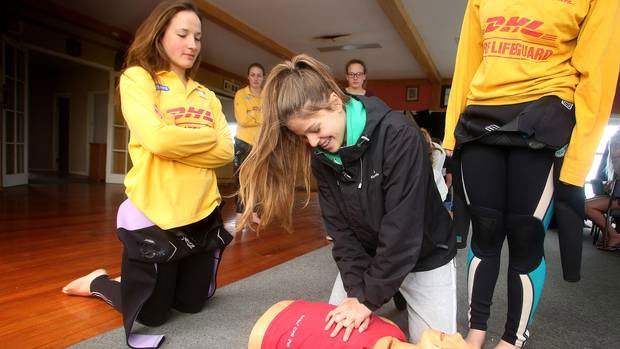When paradise turns deadly

Clarissa Nowak and Alex Forlong were involved in the rescue off Kai Iwi Beach which won rescue of the year. The majority of the rescuers were past/present WHS students.
PHOTO / Bevan Conley
The daring rescue of stranded swimmers from a Kai Iwi Beach cove in powerful king tide waves has won Wanganui Surf Lifeguard Service the rescue of the year awards from surf life saving's national body.
Two IRBs and swimmers were used to successfully extract a father and daughter from the cove over three hours on the afternoon of February 18 while the dramatic operation was coordinated from the club's new watch tower.
"It means a massive amount to the club," lifeguard Matthew Newell said.
He was one of nine lifeguards along with James Newell, Phil Gilmore, Laura O'Keeffe, Clarissa Nowak, Sophie Couper, Laurie Gil, Alex Forlong and Kaya Dobbie were involved in the rescue and received the gong at the Surf Life Saving New Zealand's Awards of Excellence on Saturday.
The rescue began when police called Wanganui SLS chairman James Newell with reports of two swimmers missing off Kai Iwi Beach just after 12pm on the day.
The sea was too rough for Coastguard to get out and with half an hour O'Keeffe and Forlong were out on the water in an IRB.
The king tide was 30 minutes from peaking and 2m storm waves were smashing along the cliffs.
Meanwhile, Dobbie and Matthew Newell were set up in the newly built watch tower, along with Police and Coastguard, communicating with the rescuers on the water.
The man and his daughter had sought refuge in a small cove trying to get out from the smashing waves.
Matthew Newell said it was the way the lifeguards worked with other agencies which was a key factor in the win.
"They respected our knowledge and expertise around the surf and respected the way we wanted to execute the operation," he said.
"It was pretty horrible weather, it was pretty horrible surf. The girl had an injured foot and was becoming hypothermic."
But to pull it ofs perfectly showed the capability of the Whanganui crew, Newell said.
"We have an awesome bunch of lifeguards coming through showing lots of potential and all our guards are trained to a high standard."
Experienced IRB driver O'Keeffe dropped Forlong into the water to collect the patients but the surf was too powerful and she injured her hand against the rock before swimming back to the IRB.
It was decided the cliff was too unstable for the rescue helicopter to winch the patients or for the fire service to abseil and lifeguards had decided to dispatch a second IRB from Castlecliff with Gilmore.
James Newell decided the safest option was to extract the pair using the two IRBs and swimmers.
The lifeguards had short intervals of between 30 seconds and two minutes between shore dumps to take an IRB into the cliffs and hide in the sets behind a slip which had formed a small island about 50m down from the patients.
After waiting for the next flat period, Nowak swam to rescue the young girl and take her back to the IRB, waiting for yet another calm patch before returning to shore.
The same procedure was used to rescue the girl's father, who was unharmed.
The whole operation used nine lifeguards, two IRBs, an ambulance, eight police officers, two fire engines and a helicopter.
SLSNZ said all of the lifeguards involved performed extremely well using good radio communication from the watch tower base.
By Zaryd Wilson
Whanganui Chronicle 25/9/18


